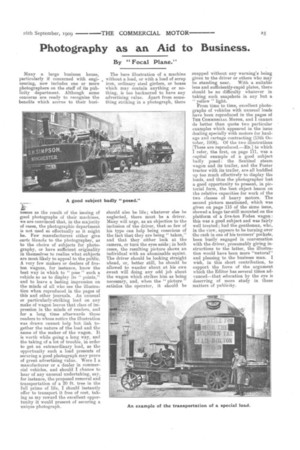Photography as an Aid to Business.
Page 3

If you've noticed an error in this article please click here to report it so we can fix it.
By "Focal Plane."
Many a large business house, particularly if concerned with engineering, now includes one or more photographers on the staff of its publicity department. Although some concerns are ready to recognize the benefits which accrue to their busi
misses as the result of the issuing of good photographs of their machines, we are convinced that, in the majority of cases, the photographic department is not used so effectually as it might be. Few manufacturers either give carte blanche to the photographer, as to the choice of subjects for photography, or have sufficient originality in themselves to realize what subjects are most likely to appeal to the public. A very few makers or dealers of five-. ton wagons, for instance, know the best way in which to " pose " such a vehicle so as to display its " points," and to leave a lasting impression on the minds of all who see the illustration when reproduced in the pages of this and other journals. An unusual or particularly-striking load on any make of wagon leaves that class of impression in the minds of readers, and for a long time afterwards those readers to whose notice the illustration was drawn cannot help but link together the nature of the load and the name of the maker of the wagon. It is worth while going a long way, and the -taking of a. lot of trouble, in order to get an extraordinary load, as the opportunity such a load presents of securing a good photograph may prove of great advertising value. Were I a manufacturer or a dealer in commercial vehicles, and should I chance to hear of any unusual undertaking, say. for instance, the proposed removal and transportation of a 20 ft. tree in the full prime of life, I should instantly offer to transport it free of cost, taking as my reward the excellent opportunity it would present of securing a unique photograph.
The bare illustration of a machine without a load, or with a load of scrap iron, ordinary steel girders, or boxes which may contain anything or nothing, is too hackneyed to have any advertising value. Apart from Gamething striking in a photograph, there
should also be life ; whatever else be neglected, there must be a driver. Many will urge, as an objection to the inclusion of the driver, that so few of his type can help being conscious of the fact that they are being " taken," and that they either look at the camera, or turn the eyes aside ; in both cases, the resulting picture shows an individual with an abominable squint. The driver should be looking straight ahead, or, better still, he should be allowed to wander about at his own sweet will doing any odd job about the wagon which strikes him as being necessary, and, when the " picture " satisfies the operator, it should be
snapped without any warning's being given to the driver or others who may be standing near. With a suitable lens and sufficiently-rapid plates, there should be no difficulty whatever in taking such snapshots in any but a " yellow "
From time to time, excellent photographs of vehicles with unusual loads have been reproduced in the pages of Tnz Commanast MOTOR, and I cannot do better than quote two particular examples which appeared in the issue dealing specially with motors for haulage and cartage contracting (15th October, 1908). Of the two illustrations [These are reproduced.—En.] to which I refer, the first, on page 111, was a capital example of a good subject hadly posed : the Sentinel steam wagon and its trailer, and the Foster tractor with its trailer, are all huddled up too much effectively to display the loads, and thus the photographer lost a good opportunity to present, in pictorial form, the best object lesson on the relative capacities for work of the two classes of heavy motors. The second picture mentioned, which was given on page 115 of the same issue, showed a huge tar-still mounted on the platform of a five-ton Foden wagon : this was a good subject and was fairly well treated; had the gentleman, who, in the view, appears to be turning over the cash in one of his trousers' pockets, been busily engaged in conversation with the driver, presumably giving instructions to the latter, the illustration would have been more "natural" and pleasing to the business man. I wish, in -this short contribution, to support the force of the argument which the Editor has several times advanced—that education by the eye is deserving of more study in these matters of publicity.




















